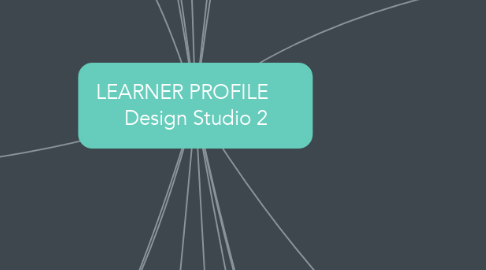
1. Why are they studying this degree?
1.1. Like that it mixes creativity and academics
1.2. Wide range of opportunities within architecture compared with other design-based degrees
1.3. General interest in architecture
1.4. Potential to help people in the future
2. Why did they choose to study at Otago Polytechnic?
2.1. Otago Polytech is close to home
2.2. Like the practical nature of polytech compared to university
2.3. University is too intimidating
2.4. Disliked lack of creativity in university
2.5. Small class sizes
2.6. Suits learning style
3. How will they apply their knowledge after completing the degree?
3.1. Continue to study - complete a (MArch) Masters in Architecture
3.2. Register as an Architect
3.3. Work in an architectural practice
3.4. Work in the sound engineering/acoustics field
4. Life and work experiences
4.1. NCEA level 3
4.2. BDes (fashion)
4.3. Job in print design / manufacturing
4.4. University (science, health science, unspecified
5. What do they already know about this topic?
5.1. Knowledge from semester 1 (learners have completed two projects for this course, which follow a similar design approach and introduce design language)
5.2. Learners with experience in fashion studies will have an understanding of design language and processes
5.3. Construction knowledge
5.4. Some learners have a knowledge of basic architectural / design principles from high school subjects (e.g. graphics, painting)
6. Learner capabilities
6.1. Communicates effectively in writing
6.2. Communicates effectively verbally
6.3. Communicates effectively visually
6.4. Displays effective interpersonal behaviour
6.5. Displays cultural competence
6.6. Displays bi-cultural proficiency in a NZ context
6.7. Works independently
6.8. Works in teams
6.9. Reflects on performance and applies personal learning
6.10. Acts responsibly
6.11. Practices health and safety
6.12. Demonstrates digital competence
6.13. Organises effectively
6.14. Demonstrates resilience
6.15. Thinks creatively
6.16. Displays leadership
6.17. Inspires others
6.18. Enterprising
6.19. Practices sustainably
6.20. Practices ethically
6.21. Thinks critically
6.22. Solves problems
6.23. Communicates bilingually
6.24. Displays work life balance
7. What do they enjoy mot about this course?
7.1. Freedom to explore, think, solve problems
7.2. The creative challenge of the design process
7.3. Hands-on nature of design, physically making things
7.4. Being able to develop an idea into a building
7.5. Not having to rote-learn material
7.6. Material exploration
7.7. Being able to throw ideas around without needing a perfect answer
7.8. Having a real life site to work from
8. What do they enjoy least about this course?
8.1. Deadlines
8.2. Struggle to think conceptually
8.3. Presenting to large groups
8.4. Working with white card
8.5. Making models
8.6. Workbook process
9. Educational level
9.1. NCEA Level 2
9.2. NCEA Level 3
9.3. NZ Certificate in Cookery (Level 3)
9.4. NZ Certificate in Digital Media and Design (Level 4)
9.5. Certificate in Fashion Studies (Level 4)
9.6. Bachelor of Design (Fashion)
10. Personal characteristics
10.1. Gender
10.1.1. Male 43%
10.1.2. Female 57%
10.2. Age
10.2.1. 18-20 61%
10.2.2. 20-25 30%
10.2.3. 25-30 4.5%
10.2.4. 45-50 4.5%
10.3. Ethnicity
10.3.1. NZ European/Pakeha
10.3.2. Other European
10.3.3. NZ Maori
10.3.3.1. Ngāti Whātua o Ōrākei
10.3.3.2. Ngāti Kahu
10.3.3.3. Ngāti Tama
10.3.3.4. Te Atiawa
10.3.4. Dutch
10.3.5. South-East Asian
10.3.6. Chinese
10.3.7. Indian
10.3.8. Other
10.3.9. Not Stated
11. Potential barriers to learning
11.1. Debt/ financial issues
11.2. Family commitments
11.3. Literacy challenges
11.3.1. strategy - employ a variety of active learning strategies
11.3.2. strategy - encourage learners to talk openly about their preferred learning styles / processes
11.4. Lack of motivation
11.5. Numeracy barriers
11.5.1. strategy - allow more time for learners to work strategy - through ideas / process information
11.6. Juggling work commitments with expectations of the course
11.7. Fear of using the workshop
11.7.1. strategy - organised induction for all learners at workshop in week 1
11.7.2. strategy - encourage use of workshop for group model-making process
11.8. Sports commitments
11.9. Mental health/wellbeing
11.9.1. stress
11.9.2. anxiety
11.9.3. fatigue
11.9.4. medication
11.10. Technology issues (during Covid)
12. How will they be studying this topic?
12.1. Face to face lectures
12.2. Group discussions
12.3. Group tasks
12.3.1. working in groups to make site models
12.3.2. participation in interim review presentations and discussion
12.4. Individual design processes
12.4.1. site analysis
12.4.2. massing models
12.4.3. design iterations
12.4.4. space planning
12.4.5. refining & developing concepts
12.4.6. presentation drawings and models
12.5. Individual discussions with lecturer throughout the design process
12.6. Use of workshop to make physical models - both as a group an individually
12.7. Formative assessments
12.7.1. project is broken into four sections with an interim review at the end of the first three sections
